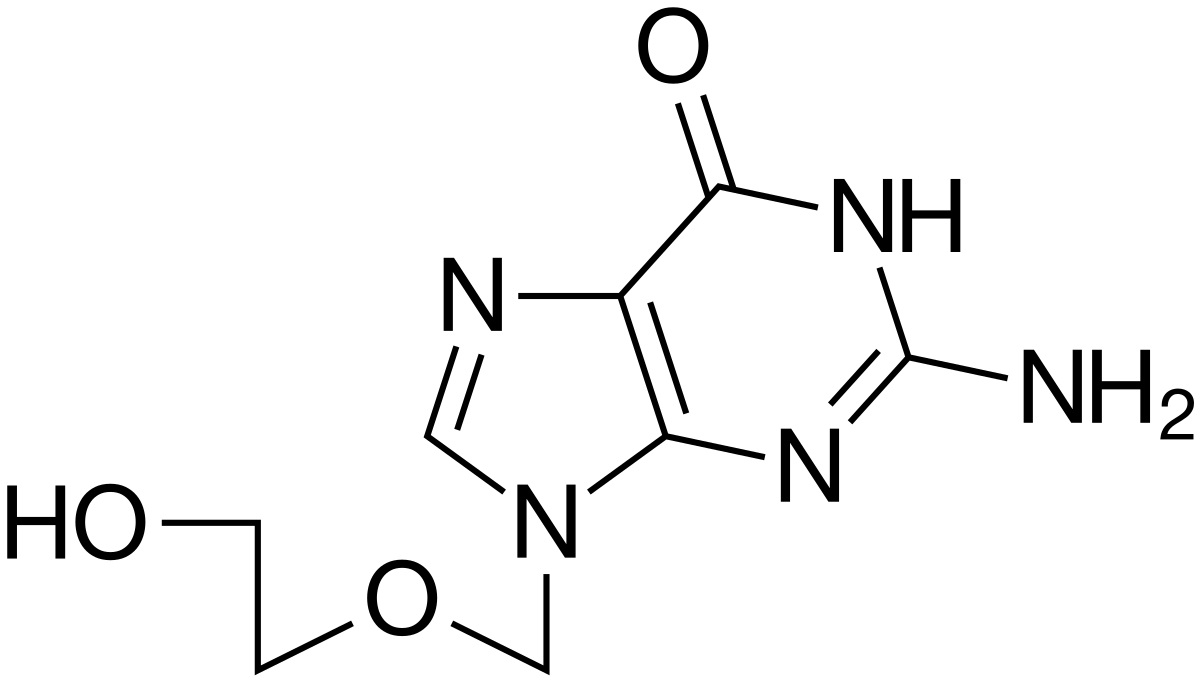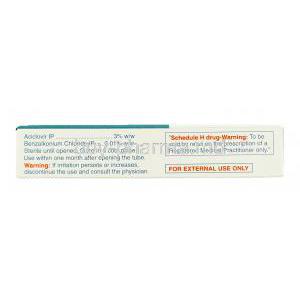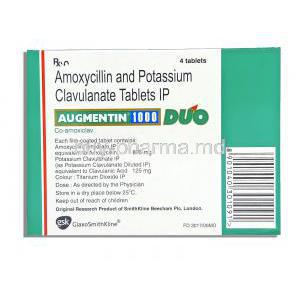Acyclovir Eye Ointment
- Introduction
- Uses of Acyclovir Eye Ointment
- How Acyclovir Eye Ointment Works
- Dosage and Administration
- Composition of Acyclovir Eye Ointment
- Common Side Effects
- Serious Side Effects and Warnings
- Off-Label Use of Acyclovir Eye Ointment
- Interactions with Other Medications
- Contraindications
- Careful Administration Considerations
- Important Precautions
- Special Populations: Administration Details
- Overdosage and Its Implications
- Storage of Acyclovir Eye Ointment
- Handling Precautions
Introduction
Origin and Development of Acyclovir Eye Ointment
Acyclovir, a compound in the history of antiviral therapies, was first identified in the late 1970s. It is a nucleoside analog, and its discovery marked a pivotal moment in the field of antiviral treatments. As medicinal chemistry progressed during that era, scientists recognized its potential for combating the herpes simplex virus. This realization led to research, creating an eye ointment to treat eye-related ailments.
Importance in Ophthalmological Therapeutics
In ophthalmology, Acyclovir eye ointment has established itself as a valuable and essential treatment. With ocular infections caused by the herpes simplex virus (HSV), this medication has become integral to standard treatment protocols.
- Prominent Protection: The unique formulation of Acyclovir eye ointment creates a barrier that effectively prevents the proliferation of viruses in the delicate eye environment.
- Targeted Approach: Its specific action ensures harm to the surrounding eye tissues, focusing solely on addressing the infection.
- Pharmacological Dependability: The consistent therapeutic effects of Acyclovir eye instill confidence among medical professionals, making it a reliable choice for treatment.
Uses of Acyclovir Eye Ointment
Primary Indications: Treating Herpes Simplex Virus Infections
The cornea is particularly vulnerable to the Herpes Simplex Virus, the type 1 strain (HSV 1)1. If left untreated, these infections can cause complications ranging from minor opacities in the cornea to permanent vision loss. Using Acyclovir eye ointment acts as a defense against HSV by stopping the virus early on, preventing severe eye problems.
Benefits for Ocular Health and Clarity
The ointment offers advantages beyond its ability to fight viruses. It helps keep the cornea clear by reducing the impact of attacks. Additionally, it prevents scarring, a common consequence of HSV infections caused by inflammation. Furthermore, it relieves the discomfort typically associated with HSV infections, enhancing patient comfort.
How Acyclovir Eye Ointment Works
Mechanism of Action against Viral Infections
The core principle of how Acyclovir works revolves around its ability to imitate guanosine, a nucleoside. When it enters a cell infected with a virus, Acyclovir goes through phosphorylation, transforming into its state. This active form cleverly integrates into the DNA, causing the synthesis process to be shortened and ultimately stopping the virus from replicating.
Target Areas in the Eye
The cornea is the focus of HSV in the complex structure of the human eye. Acyclovir eye ointment, designed to target this transparent front part, works by reaching deep into the layers of the cornea. Efficient drug delivery ensures that the entire tissue is protected from invaders.
Dosage and Administration
Recommended Dosage for Different Conditions
The effectiveness of Acyclovir eye ointment depends on how it's applied correctly. Various eye conditions require dosage:
- Primary Keratitis: Apply a layer five times daily with approximately four-hour intervals between each application.
- Stromal Keratitis and Uveitis: The frequency might increase every three hours depending on the severity of the condition.
- Recurrent cases: Applying the ointment three times a day often helps prevent outbreaks.

Proper Application Techniques
To achieve the results during therapy, it's essential to follow proper application techniques3:
- Hand Hygiene: Begin by washing your hands to avoid any potential contaminants.
- Posture: Tilt your head backward and use one hand to pull down your lower eyelid, creating a small pocket gently.
- Application: Carefully squeeze out an amount of ointment into the pocket without letting the tube touch your eye. Blink a few times to spread the cream evenly.
- Closure: Immediately recap the tube after applying the ointment to maintain sterility.
Following these steps will help ensure therapeutic outcomes.
Frequency and Duration of Treatment
It is essential to follow the recommended frequency. Usually, the treatment lasts for a period of 7 to 10 days5. However, doctors may suggest continuing it until there is improvement in the patient's condition. Just because the symptoms have stopped doesn't necessarily mean the issue is entirely resolved; patients must continue the treatment for the entire prescribed duration.
Composition of Acyclovir Eye Ointment
Active Ingredients and Their Roles
The effectiveness of Acyclovir eye ointment lies in its component, Acyclovir. This antiviral substance interferes with the herpes simplex virus ability to replicate making it ineffective. Its remarkable skill in hindering DNA synthesis gives it unmatched therapeutic power.

Inactive Ingredients and Their Functions
While the main ingredient often gets all the attention, it's essential not to overlook the heroes. The inactive components. That also plays a crucial role. White Soft Paraffin, for example, contributes to the ointment's texture, making it easy to apply. Liquid Paraffin helps maintain the ointment's moisturizing properties, while Propylene Glycol acts as a humectant to ensure the formulation stays hydrated.
Common Side Effects
Mild to Moderate Side Effects: Symptoms and Management
Although Acyclovir eye ointment is usually well tolerated, there are some to moderate side effects6 that may occur:
- Burning: It's common to feel a brief burning sensation after applying the ointment, but it typically disappears quickly.
- Superficial Keratopathy: Some patients may notice dots on the cornea, but these are temporary and often resolve independently.
- Blepharitis: Inflammation of the eyelids is rare. This should be discussed with a healthcare professional for further guidance.
Duration and Alleviation Measures
Most side effects tend to decrease within a week after starting the treatment. Following the application instructions is essential to minimize any potential side effects. If any negative reaction persists or worsens, seeking advice promptly is crucial. Simple measures, like soothing remedies or adjusting the dosage, often resolve the issue without stopping the treatment.
Serious Side Effects and Warnings
Recognizing Severe Reactions and Risks
The therapeutic experience with Acyclovir eye ointment is generally safe for people. However, a small number of individuals may experience severe reactions. It is essential to be aware of these reactions:
- Anaphylaxis: This is an allergic reaction that can cause hives, difficulty breathing, and swelling of the face, lips, or tongue.
- Severe Eye Pain: If you experience pain after applying the ointment, especially if accompanied by reduced vision, it is essential to seek immediate medical attention.
- Persistent Redness and Inflammation: If redness and inflammation continue after trying common remedies, it could be a sign of a worsening condition.
It's crucial to be vigilant and seek help if any of these severe reactions occur.
Immediate Steps and Medical Interventions
If you experience symptoms, it's crucial to take immediate action. Stop using the ointment until you seek medical advice. It's essential to see an eye specialist to determine the cause of the problem and take appropriate corrective measures. If your symptoms indicate an allergic reaction, you must visit the nearest emergency department immediately.
Off-Label Use of Acyclovir Eye Ointment
Other Conditions it Might Treat
Although Acyclovir is primarily used for treating herpes simplex infections, there have been suggestions about its potential effectiveness against the Varicella Zoster Virus, which causes chickenpox and shingles, mainly when it affects the eyes. Additionally, some medical professionals believe that Acyclovir might reduce the severity of Adenoviral Keratoconjunctivitis; however, conclusive evidence is still lacking.
Efficacy and Research Findings
The exploration of uses for Acyclovir eye ointment is still in its early stages but showing promising growth. While specific studies hint at its effectiveness, scientists have not unanimously agreed. It is necessary to conduct thorough and extensive randomized controlled trials in this therapeutic field to establish its position.
Interactions with Other Medications
Drugs to Avoid While Using Acyclovir Eye Ointment
It is essential to be careful about interactions between medications to ensure proper use of pharmacological treatments. While the absorption of Acyclovir from eye ointment is minimal, it is wise to exercise caution when using it in combination with the following:
- Immunosuppressants: Using Acyclovir alongside immunosuppressants may increase the risk of experiencing reactions.
- Other topical ophthalmic medications: It is recommended to wait at least 10 minutes between applying different eye medications to avoid potential interactions.
It's always better to err on caution and take steps for safe medication use.
Potential Consequences of Concurrent Use
Using Acyclovir concurrently with medications can lead to unexpected changes in how the drugs work in the body. These changes could. Weaken the effectiveness of Acyclovir or worsen its side effects. It's essential to have communication with your healthcare provider about any other medications you are taking to ensure a safe and effective treatment.
Contraindications
Situations and Conditions Where Usage is Discouraged
Acyclovir eye ointment, although it can be helpful for eye conditions, may not be suitable for everyone. There are situations or underlying conditions where caution or complete avoidance might be necessary:
- Ocular Surface Disease: If someone already has existing issues with their surface, using Acyclovir may worsen their condition upon application.
- Recent Eye Surgeries: The eyes are more vulnerable after undergoing eye surgery. It is essential to have a clinician oversee the use of Acyclovir in these cases to avoid any harm.
- Active Bacterial Infections: Acyclovir is specifically designed to combat viruses. It is ineffective against bacterial infections. Using it in cases may mask or complicate the clinical presentation.
It's crucial to consider these factors before using Acyclovir eye ointment and consult with a healthcare professional if there are any concerns or questions about its suitability.
Individual Allergies or Sensitivities
Allergic reactions to Acyclovir or its ingredients should not be overlooked, as they can occur with any medication. It is best to avoid using it if you have a hypersensitivity to Acyclovir or similar compounds. Additionally, if you experience any reactions after applying it for the first time, you should stop using it and consult a doctor.
Careful Administration Considerations
Factors Influencing Dosing Decisions
Some factors come together to affect how Acyclovir eye ointment is dosed. The severity of the infection plays a role, as severe cases may require more frequent dosing. Age and physiological status also matter; children and older adults may respond differently and need adjusted dosing. Additionally, if other medications are being taken at the time, they can impact how the body processes Acyclovir and, therefore, influence dosing decisions.
Tailoring Treatment to Individual Needs
Medicine combines both art and science. Generic approaches rarely meet the needs of every individual. Adapting how Acyclovir is administered to suit each person's characteristics helps achieve the best possible treatment results while reducing potential risks. Regular evaluations during the initial stages of treatment offer valuable information that enables real-time adjustments to the treatment plan.
Important Precautions
Pre-Application and Post-Application Care
To maintain the cleanliness and integrity of the eye environment before and after applying the ointment, it is crucial to follow these steps:
- Prioritize Cleanliness: Thoroughly clean your hands before starting the application process. This helps prevent any introduction of contaminants.
- Ensure Sterility: Avoid contact between the nozzle of the tube and your eye surface and any other characteristics.
- Allow for Post Application Rest: keep your eyes closed briefly after applying the ointment. This allows for retention of the cream and prevents accidental expulsion.
Recognizing Early Signs of Adverse Reactions
Detecting and addressing adverse reactions early on is crucial. It's normal to experience mild stinging after applying the product. If you notice persistent discomfort, increased redness, or decreased visual clarity, it's essential to be cautious. Stop using the product immediately. Consult an eye specialist as soon as possible to prevent any potential complications.
Special Populations: Administration Details
Administration to the Elderly
Due to the physiological characteristics of elderly individuals, their reactions to Acyclovir may vary. Therefore, it is crucial to adopt an approach that considers the specific aging changes.

Adjustments and Precautions for Age-Related Concerns
The renal function of people is often reduced, which could affect how Acyclovir works in their bodies. Elderly individuals commonly take medications, increasing the chance of drug interactions. As people age, changes in the surface can occur that might require adjustments to dosage or more prolonged treatment periods.
Administration to Pregnant Women and Nursing Mothers
Medications during pregnancy or while breastfeeding involve a balance between the benefits for the mother and potential risks for the baby.

Safety, Risks, and Recommendations
- Passing through the placenta: Although only a tiny amount of Acyclovir is absorbed into the bloodstream when applied topically, it is essential to consider the potential for Acyclovir to cross the barrier.
- Breastfeeding: trace amounts of Acyclovir may enter breast milk after absorption into the bloodstream. While this amount is minimal, informing nursing mothers about this occurrence is essential.
- Considering benefits and risks: When deciding to use Acyclovir during pregnancy or while breastfeeding, assessing and weighing the potential benefits against any possible threats is crucial.
Administration to Children
When giving children Acyclovir, it's essential to consider their pharmacodynamic and pharmacokinetic characteristics and adjust the administration approach accordingly.

Pediatric Dosage and Precautions
- Weight-Based Dosing: In some cases, doctors consider a child's weight when deciding how much medication to give them. This helps ensure the medicine works effectively without putting much strain on the body.
- Surveillance: Young children who can't express themselves well may be unable to communicate with the medication if they are experiencing any adverse reactions. That's why it's essential to observe them after giving the medicine.
- Dosing Frequency: Children's bodies metabolize medications differently, so sometimes, it may be necessary to adjust how much medication they receive based on their needs.
Overdosage and Its Implications
Recognizing Signs of Excessive Application
Although Acyclovir has a therapeutic index, excessive amounts can still have consequences. It's essential to be aware of signs and symptoms that may occur after application:
- Increased Ocular Irritation: After applying the medication, you may experience intense stinging, burning, or itching sensations.
- Temporary Visual Changes: Your vision might become blurred or diminished after medication use.
- Unusual Eye Discharge: If you notice any discharge or increased tear production, it's something to watch.
Monitoring these manifestations when using Acyclovir is essential to ensure proper usage and minimize potential side effects.

Immediate Remedial Measures and Interventions
If you suspect an overdose, it is essential to take action to reduce the risk of complications. Start by rinsing the affected eye with plenty of saline solution or lukewarm water to prevent further absorption. After rinsing, it is crucial to seek medical advice to ensure no long-term consequences.
Storage of Acyclovir Eye Ointment
Optimal Conditions for Preservation
The effectiveness and shelf life of Acyclovir eye ointment greatly depend on how it's stored. It is crucial to keep it in an environment that avoids temperatures, humidity, or exposure to light.

Shelf-Life and Expiry Considerations
Every pharmaceutical product comes with an expiration date. After this date, it's not guaranteed to be safe and effective. It's advised not to use the ointment after this date. Additionally, if you notice any changes in the cream's consistency, color, or smell before it expires, stop using it.
Handling Precautions
Safe Practices for Application and Storage
To maintain the cleanliness of the ointment, it is essential to follow these guidelines:
- Handling; Before applying the cream, wash your hands thoroughly.
- Avoid Cross Contamination: Do not let the tube's nozzle contact any surface, including your eyes, as this can introduce bacteria.
- Store in Original Packaging: Keep the ointment in its packaging and store it in sunlight or heat sources.
Disposal Guidelines for Expired or Contaminated Products
When it comes to getting rid of expired or potentially contaminated ointment, it's not about throwing away a product that can't be used anymore. It's essential for the environment and public health. To ensure we dispose of these products in a way that's safe for the environment and people, it's a good idea to check with local guidelines on how to do this properly.




















